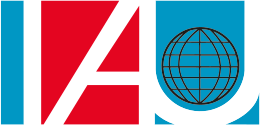International Association of Universities
 | |
| Formation | 1950 |
|---|---|
| Type | NGO |
| Headquarters | Paris, France |
Region served | Worldwide |
Membership | More than 600 members- Universities, higher education institutions & associations |
Official language | French, English |
President | Andrew J Deeks |
Executive General Secretary | Hilligje van't Land |
Main organ | IAU General Assembly |
| Affiliations | UNESCO |
| Website | IAU Official website |
The International Association of Universities (IAU) is a membership-led non-governmental organization working in the field of global higher education. It has more than 600 members in over 120 countries, including institutions, organizations, affiliates, and associates in higher education. [1] The IAU was created under and is an official associate partner of the United Nations Educational Scientific and Cultural Organization (UNESCO). [2]
Mission
[edit]Following the IAU's 15th General Conference, the IAU proclaims four priorities to advance the mission of development in higher education. These include leadership, sustainable development, internationalization, and digital transformation. [3]
History
[edit]As a result of the aftermath of World War II and the emergence of the Cold War, there was a renewed need for global cooperation. Cooperation within global higher education became a driving issue to rebuild and strengthen the world. Thus, a formal proposition of the International Association of Universities was discussed at a UNESCO General Conference in the year 1947. Three years after, the IAU held its first General Conference in Nice, France. Over the decades, the IAU has played a key role in promoting global collaboration among universities, addressing issues in higher education, and advancing sustainable development. [4] Following the first General Conference, key events included releasing two publications that formalized the standards and goals for the organization as well as the creation of international research committees in the 1960s [5].
Throughout the 1970s and 1980s, IAU expanded its vision by addressing and discussing arising problems, increasing partnerships, and releasing more publications. In the 1990s, the IAU recognized the importance of releasing policy statements as a form of discussion for current concerns, addressing issues like sustainable development and academic freedom [6].
In the 2000s, the IAU increased its focus on internationalization, launching global reports, advisory services, and global forums. It also embraced digital transformation, creating online platforms for outreach to higher education institutions. First presented in 2016 and up until today, the IAU prioritizes leadership, sustainable development, internationalization, and digital transformation. [7]
Governance
[edit]The governing bodies of the IAU are the General Assembly and the Administrative Board. [8] The General Conference, convened every five years, votes an administrative board consists of the president and 14 members.[9] The Secretariat implements the strategy adopted by the governing bodies.
Membership
[edit]The IAU counts almost 600 members in over 120 countries worldwide. [10] These members span diverse geographical regions and focus on collaboration, knowledge exchange, and innovation in higher education. There are four different member classes within the IAU including institutions, organizations, affiliates, and associates. [11] The majority of the organizations' membership is occupied by higher education institutions. [12] There are a variety of benefits that members of the IAU utilize including networking opportunities, resources for development, and being actively involved in both organizational and global decision making. [13] Access to benefits alters with member status. Each member category has a specific admission criteria and application process. To become a member institution of the an application must be submitted and accepted given that the institution aligns with the mission and meets a set of characteristic requirements. [14] Becoming a member organization is open to associations and networks of higher education institutions. [15] Affiliate membership is offered for those organizations that align with the IAUs mission but do not meet certain characteristic admission criteria. [16] Individuals who have expertise in higher education can apply for associate membership. [17] There is a financial requirement annually which varies depending on member class and origin country income. [18]
References
[edit]- ^ "Members - IAU". www.iau-aiu.net. Retrieved 2024-10-10.
- ^ "International Association of Universities - UNESCO Archives AtoM catalogue". atom.archives.unesco.org. Retrieved 2024-10-11.
- ^ "International Association of Universities | HER2023". highereducationreform.org. Retrieved 2024-10-11.
- ^ "A Note On The International Association Of Universities And Its Permanent Secretariat", A Note On The International Association Of Universities And Its Permanent Secretariat, De Gruyter, pp. 1185–1188, 2020-10-26, doi:10.1515/9783112328187-122/pdf?licensetype=restricted, ISBN 978-3-11-232818-7, retrieved 2024-10-31
- ^ "IAU over the years - IAU". www.iau-aiu.net. Retrieved 2024-10-31.
- ^ "IAU over the years - IAU". www.iau-aiu.net. Retrieved 2024-10-31.
- ^ "IAU over the years - IAU". www.iau-aiu.net. Retrieved 2024-10-31.
- ^ "Governance Structure - IAU". www.iau-aiu.net. Retrieved 2024-10-07.
- ^ The Editors of Encyclopaedia Britannica (2024). "International Association of Universities." The Encyclopaedia Britannica, retrieved online 11.02.2024.
- ^ "International Association of Universities | Council for Higher Education Accreditation". www.chea.org. Retrieved 2024-10-07.
- ^ "Members - IAU". www.iau-aiu.net. Retrieved 2024-10-10.
- ^ "List of IAU Members - IAU". www.iau-aiu.net. Retrieved 2024-10-10.
- ^ Zapp, M., Jungblut, J. & Ramirez, F.O. Legitimacy, stratification, and internationalization in global higher education: the case of the International Association of Universities. Tert Educ Manag 27, 1–15 (2021). https://link.springer.com/article/10.1007/s11233-020-09062-0
- ^ "Join IAU - IAU". www.iau-aiu.net. Retrieved 2024-10-10.
- ^ "Join IAU - IAU". www.iau-aiu.net. Retrieved 2024-10-10.
- ^ "Join IAU - IAU". www.iau-aiu.net. Retrieved 2024-10-10.
- ^ "Join IAU - IAU". www.iau-aiu.net. Retrieved 2024-10-10.
- ^ Zapp, M., Jungblut, J. & Ramirez, F.O. Legitimacy, stratification, and internationalization in global higher education: the case of the International Association of Universities. Tert Educ Manag 27, 1–15 (2021). https://link.springer.com/article/10.1007/s11233-020-09062-0
